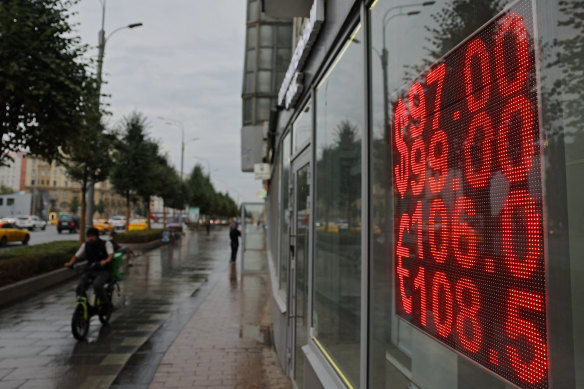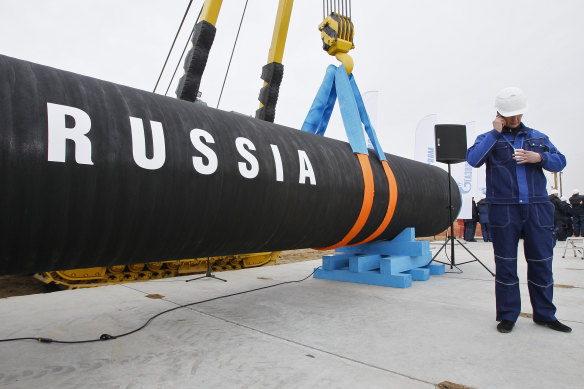This was published 1 year ago
Opinion
Running out of money: Vladimir Putin’s moment of truth has arrived
By Ambrose Evans-Pritchard
The curse of August has struck again in Russia. The long-awaited currency crisis has finally hit as a collapse in usable energy revenues bleeds the Kremlin dry, and the slow damage of G7 sanctions eats away at the country’s economic foundations.
The rouble has fallen by 40 per cent since November, when it became clear what Russia was up against: an unbroken Ukraine able to pack a military punch; a West that was refusing to fracture; and an oil price cap that the Kremlin never thought would happen.

The faltering rouble is piling pressure on Putin. Credit: Reuters
The pace of devaluation has quickened since the Prigozhin mutiny. Over the last week, the rouble has broken its mooring, briefly blowing through the psychological line of 100 to the dollar. The central bank raised interest rates to 12 per cent in an emergency move on Tuesday but this has so far failed to restore confidence.
Russia now faces a drastic tightening of financial conditions and a currency slide at the same time.
Vladimir Putin can no longer maintain his line that the exchange rate slide is a calibrated and deliberate move in budget management. He touted rouble strength all last year as proof of Russia’s economic invulnerability.
“They are talking about it in every kitchen in Russia,” said financial journalist Orlon Skim.
Tim Ash from Chatham House said the devaluation is an internal propaganda disaster and “the clearest signal yet that the oil price cap and sanctions are working”.
Russia is running out of usable hard currency, to the point where Aeroflot has been landing at least nine of its Boeing and Airbus passenger jets with their brakes switched off because the airline is struggling to obtain parts at viable cost, and can no longer service its fleet in the West.
Pilots have to rely on reverse-thrust alone. A leaked memo obtained by Aviatorschina warned them of the risk of “overrunning the runway” in wet weather. This is a country in dire straits. Only in the magical world of Russian statistics did the economy grow 4.9 per cent in the second quarter, year-on-year.
Russia can, of course, buy anything it really needs on the global black market, mostly funnelled through Turkey, Dubai, or central Asia. German exports to Kazakhstan are up 105 per cent over the last year. Mirabile dictu.

Russia is running out of usable hard currency.Credit: Reuters
Russia has switched to Chinese semiconductors – as well as cannibalising dishwashers and fridges – but these are mostly workhouse chips, too low-tech for advanced warfare. It would take years to configure Chinese circuits for Russia’s existing industrial system, and so far Chinese companies have been strikingly reluctant to do so.
The weapons captured or shot down in Ukraine overwhelmingly contain US chips acquired before the war. Russia has an elaborate smuggling network to obtain replacements but this costs hard currency. That is what Putin no longer has.
Russia enjoyed a revenue bonanza last year from booming energy, metal, and grain prices. Commodity revenues pushed the current account surplus to 20 per cent of GDP, allowing Putin to finance the war and uphold the social welfare contract at the same time.
That surplus has largely evaporated. Ash said Russian energy sales to Europe have dropped to €2 billion ($3.4 billion) a month from €12 billion a month last year. Gazprom has essentially lost its €60 billion annual gas market in Europe forever. The gas pipelines from the west Siberian fields cannot be switched to China without vast investment.
Putin is still selling near record volumes of oil, as intended under the sanctions regime. The point of the $US60 oil cap is to keep the world economy well-supplied with crude, while depriving the Kremlin of a slice of the earnings.
Either Putin ships his oil though the Western-controlled nexus of tankers and insurance, and accepts the price cap; or he ships it in his own shadow fleet with complex and costly refuelling off Gibraltar or the Greek islands. He loses $US8 to $US10 a barrel sending the oil halfway around the world to Asia. The Indians and the Chinese know he is a distressed seller and are driving a hard bargain.
The International Energy Agency says the discount on Russian Urals crude has narrowed. The price averaged $US64 in July but that is still significantly lower than Brent near $US80 at that time. How much of that reaches Russia after transport costs and fees for middlemen is an open question.
To the extent that we can believe any Russian data at this stage, Kremlin revenues collapsed by 47 per cent in the first half of the year. The budget deficit is running at an annualised pace of $US50 billion ($77.5 billion) even on the official figures. The Kremlin cannot borrow abroad and lacks a deep and liquid bond market at home.
Some $US330 billion of foreign exchange reserves are frozen under G7 sanctions. The remaining $US260 billion are not all liquid or usable. The central bank estimates that $US253 billion of capital has left the country since the war began.
The Kremlin is now raiding private companies, forcing them to pay “voluntary” contributions to the war effort. The founders of Yandex, Russia’s “Google”, the telecom company Vimpelcom, and the digital bank Tinkoff have all been driven into exile, effectively expropriated or coerced into selling cheaply.
Putin is seizing the assets of Western companies. Danone, Carlsberg, Forum, and Uniper, have all been targeted, partly in order to distribute patronage to loyalists and shore up the regime. Those that leave have to sell their subsidiaries at a minimum discount of 50 per cent, and then pay a 10 per cent exit tax. It cost BP $US24 billion to write off its 20 per cent holding of Rosneft.
Covering the budget shortfall by this sort of scavenging has reached its limits. The falling rouble flatters the fiscal deficit because it raises the nominal rouble revenues from oil exports, but that effect is quickly overwhelmed by the inflationary sting in the tail.

Russia enjoyed a revenue bonanza last year from booming energy, metal, and grain prices but that surplus has largely evaporated. Credit: AP
The treasury has had to dip into the national welfare fund, down $US16 billion since May to $US146 billion, and not all of that is liquid. The Kremlin has suspended the budget rule requiring that a share of energy revenues is salted away in foreign assets. This move failed to stabilise the rouble.
Russia is now caught in a classic emerging market crisis. The more that Putin’s circle tries to scapegoat central bank chief Elvira Nabiullina, the technocrat holding Russia’s finances together, the greater the likelihood of igniting an inflation-devaluation spiral, with no possibility of an IMF bail-out when it all goes wrong.
This may not yet be the final chapter for Putin but the rouble crisis rebuts the widely repeated claim that time works to his advantage in Ukraine. He is running out of plunder to buy off the hard-bitten business interests and private militias that underpin his regime.
A reader of this newsletter suggested that the West should lift all sanctions against Russian oligarchs instead of hounding them, except for those actively aiding the war. They should be encouraged to bring as much money as possible to Zurich, London, or New York, safe in the knowledge that it will not be frozen.
I agree. The imperative is to split the Russian elite and quicken capital flight. A run on the rouble is the financial equivalent of Storm Shadow missiles.
Telegraph, London
The Business Briefing newsletter delivers major stories, exclusive coverage and expert opinion. Sign up to get it every weekday morning.